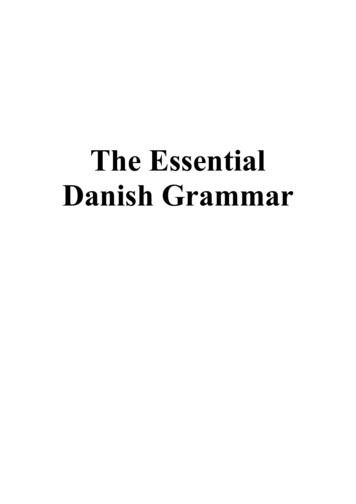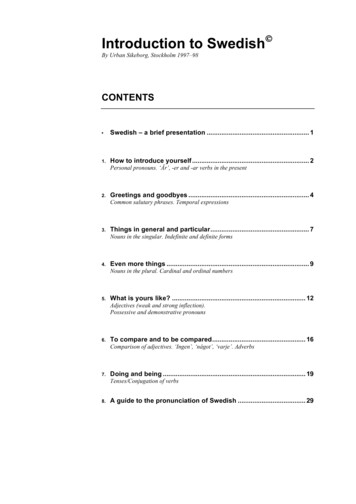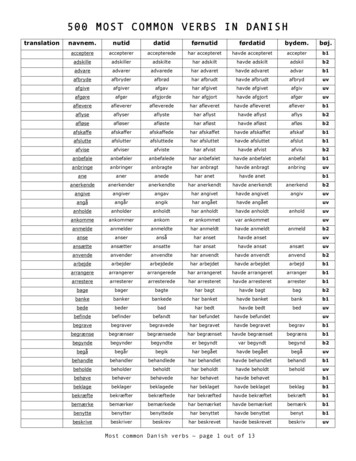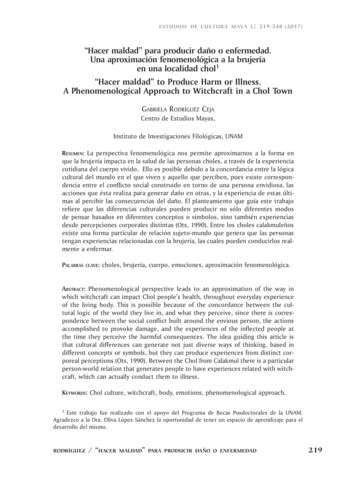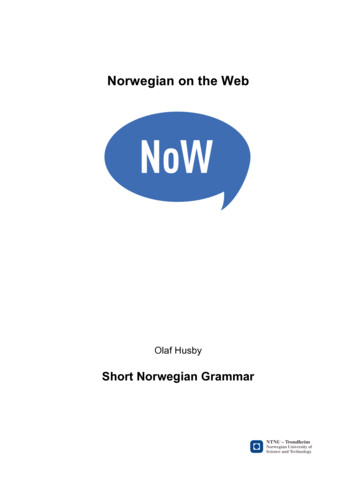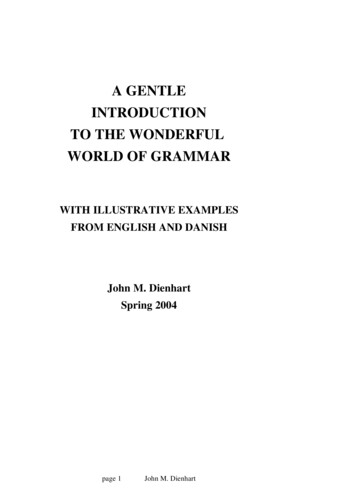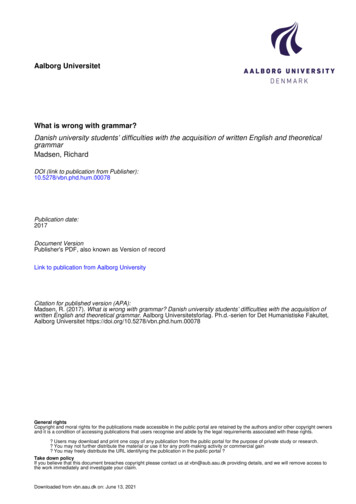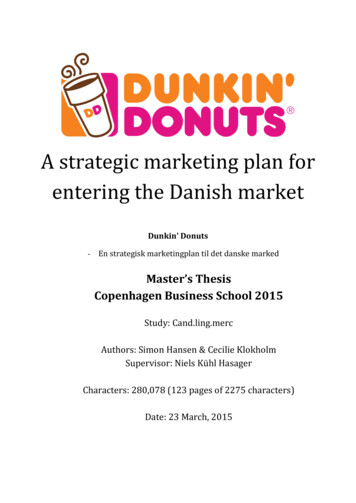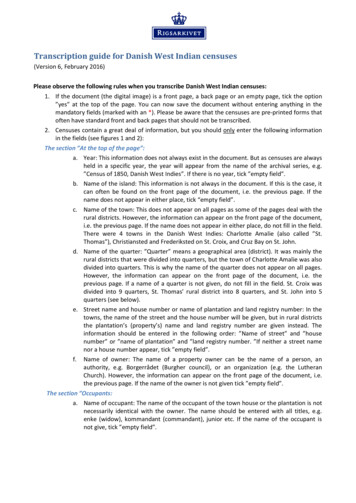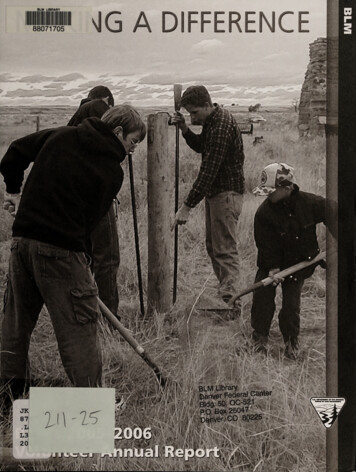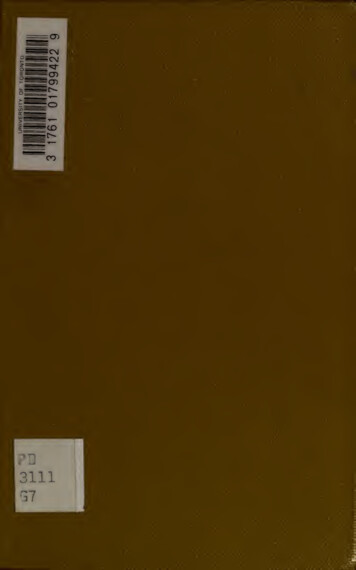
Transcription
Digitized by tine Internet Arciiivein2007witiiIVIicrosoftfunding nislidanonorwegOOgrotuoft
4 lbcatb'9 flDobernAXanQuage SerieeDANISHDano-Norwegian Grammarp.GROTH, A.M.BOSTOxN,D. C.HEATH &U.S.A.CO.,1894PUBLISHERS
VMAR3] 889209Cor-YRIGHT, 1S94By P.GROTHAll rights reskrvedPRESS OFBOSTON,U.S.A.
F*REK ACE.A S a teacherof the Danish orNorwegian languageEnglish speaking students I had very oftenlack of a reliableupmy mindgrammarandof the language,to try to supply the want.tofelt thefinally ImadeSpecial couditionswhich I have not been master have caused the time intervening between the writing of this book and its appearanceofgood deal longer than it ought to have been,about two years, and meanwhile there have appeared acouple of Danish or Norwegian grammars that may deservein print to be ai.e.thisname.reason why I have given my book the somewhat cumbersome title of a " Danish and Dano-Norwegian Grammar "will be apparent from the ** Introduction."As regards theTheuse of the book I would advise the studentfirst tomake upmind, whether he wants to study the pure Danish languageor the Dano-Norwegian language.This must to a large extent depend upon personal and practical considerations. Thetourist, the commercial traveller, the merchant may need tostudy one branch of the language or the other the literarystudent may wish to acquaint himself with genuine Danish, orhe may wish to study the vernacular of BJ0rnson and Ibsen.As a general rule I would say that the Danish pronunciation offers, with its 'glottal catch" and other peculiarities, more difficulties to the English speaking student than the Norwegianhis;*pronunciation.
IIThe student who wantsto studyDanishmust pass by§§ 81 to 146, while those who want to study Norwegianmust pass directly from §§ 8 to 81. Besides, in the "Etymology," attentionliar toisoften called to certain rules as being pecu-Danish, others to Norwegian.The student musthe needs, and pass by those that refer to thelanguage that he is not studying.select thoseIhave added some**Exercises " at the end of the book infix in his memory those rules andparadigms which he must know before he can, with any degree of success, commence reading the language.For thosewho wish more exercises I can recommend Mr. K. Brekke'sexcellent Lcereboy i Engelsk which is intended for Norwegianstudents of English, but may also to a certain extent be usedorder to help the studentThe student maythe other way.readersschools.findan abundance of goodprepared for use in the Danish and NorwegianImention only Otto Borchsenius and F. WinkelHorn's Dansk Lmsehog Eriksen and Paulsen's Norsk LcesePauss and Lassen's Lcesebog i Modersmaalet each ofthem in several volumes. As Dictionaries can be thoroughlyA. Larsen's Dansk-Norsk Engelsk Ordbogrecommendedand Kosing's Engelsk-Dansk Ordbog. To those who want tostudy the Norwegian form of the language I would recommendbog,:Norsk- engelsk ordbog and the same author'sThe touristedition of Geelmuyden's Engelsk-norsk ordbog.andPhrasesBennett'sfindPhrasebook Olsvig'sWordswillI.Brynildsen'sand the same author's Yes and No valuable guidesto famili-arity with the peculiarities of the language.This Grammar, besides being based uponmy ownstudiesand knowledge of the language, rests, as far as Danish U concerned, chiefly upon the works of Sweety Dahlerup andJespersen Jessen, Bojeseti, Lefolii and B. T. Dahl and for
Illthe Norwegianand theupon the grammarstreatises ofwhoof LbkJceand IlofgaardToStorm, Western, Brekke and /. Aars,more detailed knowledge of the languagethan can be had from this book I would recommend Poestion'sDdLnische Sprache and the same author's Lehrhuch der Norluegischen Sprache; both these books are excellent, and especially the Danish Grammar has often been of use to me inthosedesire awriting this book.Theseveral species of types that areScandinavian languages compelledmea Danish Newspaper printing office inerly equipped for awork oftopeculiartothehave this book set inNew York City, not propOn that account the ty-this kind.pographical appearance of the bookisnot in every respect asgood as I would like it to have been.Deserving of specialmention is the fact that the types ce and cb are everywhere inthe book used promiscuously to represent the latter characterexcept in §92 where the sign or is used a couple of times todenote and explain a variety of the sound of o.must acknowledge my debt of gratitude to ProJoH. feTORM of the University of Christiania forkindly sending me those advance sheets of the 2d edition ofhis *'Englische Philologie" that were of use to me in preparingthis grammar, to my honored friend Professor A. H. Palmerof Yale University for kindly reading through the larger partof the book in manuscript and making valuable suggestions,and, last but not least, to Mr. Chr. B0RS, late Consul ofNorway and Sweden at New York, without whose munificience, proverbial among Norwegians in New York, this bookwould never have seen the light of day.Finally Ifessor Dr.Brooklyn, N. Y., August 25th, 189 U.1*HEiAUTHOR.
Contents.Page.Page.1—2IntroductionThe Alphabet34DiphthongsConsonantsColloquial formsAccent11112121Sentence accent25Glottal Stop2628Quantity—65Norwegian onsQuantityVowel ChangesEtymology—294Danish SoundsVowels80853652,in inflection5863and word formation— genders6667—131Articles67Nouns70—83Gender of the nouns70Formation of the possessive76Syntactical remarks about the use of the possessiveFormation of the plural7778
VIPage.Page.83—91The AdjectivesDeclension of the adjectivesUse of the definite form of the adjectives8386Agreement of the adjective -with its noun87Comparison of adjectives87Inflection and use of tht comparative and super90lativeThe PronounsThe jersonal pronounsThe reflexive and leciprocal pionounsThe possessive pronounsThe demonstrative pronounsThe interrogative pronounsThe relative pronounsThe indefinite pronounsThe NumeralsThe 104Strong verbs107Irregular verbs113The use of the numbersThe use of the tensesThe use of the modesThe passive voice114Reflexive and impersonal verbsThe AdverbsThe PrepositionsThe ConjunctionsThe InterjectionsThe order of the words inThe PunctuationExercises114116119121122—124124—1 6126—128128—129the sentence129— 180131132—143
INTRODUCTION.SCANDINAVIAN LANGUAGES. HISTORY OF THEDANO-NORWEGIAN LANGUAGE.The Danish and Dano-Norwegian language belongs to the1.This group comScandinavian group of the Teutonic languages.prises, in modern times, besides the language already mentioned, theSwedish, Norwegian, Icelandic and Faroish languages.theThe earliest specimens2.Runic inscriptions, writtenof Scandinavian language are found inin the earlierRunic characters and dat-ing as far back as the 4th century A. D. In these inscriptions thesimilarity with the other earlier specimens of Teutonic languages (especially Gothic) is moreprominent than the peculiar Scandinavian charac-teristics.During the Viking Age (750—1000 A. D.) the language of the3.Scandinavian nations underwent a very decided change. The Scandinavian peculiarities distinguishing the language from the other Teutonic idioms appear fully developed, and by and by dialectic differencesbetween the languages of the several Scandinavian nations commenceto assert themselves.In the Middle Ages the Danish and Swedish languages form one4.group that may be designated as the Eastern group of the Scandinavian languages, having in common the monophthongification of original diphthongs, while the Danish language had a development of itsown in the direction of substituting voiced stops (mediae) or even openconsonants (spirants) for voiceless stops (tenues, hard consonants) after
INTRODUCTIOiq-.)ia long vowel at the end of a word or syllable. The Norwegian languageand its offspring the Icelandic tongue, on the other hand, form theWestern group o:*" the Scandinavian languages, having in commonthe retention of the old diphthongs as diphthongs, but with somechanges peculiar to each of the two languages. These two languagescommon with the Swedish, retained the old voiceless stops.have, in5.In the Middle Ageswe havethe most valuable literature in theNorwegian-Icelandic language,songs,theScaldic art poetry,EddieSagas and the Laws, whileconsisting chiefly of thethethe chief products of the earliestDanishlaws and popular songs (folkwriting until later.lore),theliterature are the provinciallatternot being reduced toWhen Norway in the latter part of the 14th century was united6.with Denmark, Norwegian literature fell into decay and Danish grewmore and more to be the official language used in Court Documents,In the latter part of the 17th century NorweRoyal Ordinances etc.gian authors again began to take an active part in the literature; buttheir language was Danish, this language having come to be adoptedby the educated classes of the Norwegian people and chiefly by theinhabitants of the towns and cities, while the Norwegian languagestill remained the spoken idiom of most of the rural population.Stillthe language spoken and written by the educated classes in Norwaywas never pure Danish. Norwegian authors have always used somenative words, taken from the rural dialects, in their writings, andwhile the official and professional people during the union with Denmark affected as far as possible a correct Danish pronunciation, thetendency in Norway now, even though it be unconscious, is to natioThis tendency is chiefly noticenalize the language more and more.able in the pronunciation (retaining the voiceless stops,italso appears in thebutand in thetenues),grammar, especially the syntax,vocabulary.Thus it is that we have at the present time two kinds of Danish7.language, the pureDanish used in Denmark and by Danish authors,and the Dano-Norwegian used in Norway by most of the educatedclasses, especially in the cities, and by most of the Norwegian authors.Still it should be noted that the language s p o k e n in Norway even byeducated people is far more national in its character than the one usedin writing.
THE ALPHABET.3THE ALPHABET.The alphabet usedin Danish and Dano-Norwegian litesame letters as the English alphabet and besidesAs for the soundsthese the signs JE (ae) and).(0, 0,indicated by these letters see §§ 12, 13, 25, 26, 82, 91.8.rature has theThe namesThe namesof the vowels are representedbyof the consonantsare be, ce,their sounds.de etc. (pro and A; are called h a a and k a a (a« pron.nounce d like « in name.)with a sound between 6 in h ol e and a in call), is called jod (yod), g ge(pronounced like g in give), w is called "dobbelt ve" (double v), 2 zetetc.b, c, d,;'pr. set.The Gothiccially incharacters arestillcommonin verynewspapers and popular books. Theseuse, espe-lettershave the§ 3ifollowing formsQ2153bScba. f?lk1%ic50 mm2)bd@e5fefOo9 nnUu2Jd« n)X?uVwXt 9hgs pOq9 rPqr?)t)35Wonyz5iiaej f8s2)(j6Some authors also employ the sign a, borrowed from theSwedish language, to express the same sound as is usually inDanish and Dano- Norwegian literature denoted by a a (seeabove).Note.— Capital letters areDanish rules ofemployedas substantives, while the official Norwegian orthography only acknowledges capital letters in proper nouns.A great many Danish authorsalso have done away with capital letters in common nouns.stillaccording toofficialspelling used at the beginning of substantives and adjectivesThe sounds of the Danish andthe Dano-Norwegian branchesof the language are so widely different, that it bas beenpractical to treat ofthemin separate chapters.found
DANISHSOUIsTDS.DANISH SOUNDS.VOWELS.9. Table of Danish vowels classifiedaccording to theirarticulation.(A period' up in the line after a vowel indicates length of the rrow0*e- e00-m« 8Wideyarrow1[10.aa-aWideFor the8686*0*aabenefit of those not familiar with the phonetic terms asby Mssrs. Bell, Sweet and others it is here remarked, tliatthe terms "Back", "Mixed" and "Front" refer to the horizontal articulation of the tongue, indicating what part of the tongue has to beraised from its normal position in order to form such an articulation asestablishedto produce the vowel in question.those mentioned are designatedIntermediate positions betweenby the names "advanced"and "retracted" or "inner".The words "High", "Mid" and "Low"tion of the tongue.Anrefer to theor "outer"vertical posi-intermediate position between two of thesepositions may be described as a lowering of the position immediatelyabove or a raising of the one below.
DANISH SOUNDS.5The terms "Narrow" and "Wide" refer to the shape of the tongue."In forming "narrow" soimds there is a feeling of tenseness in that partof the tongue where the sound is formed, the surface of the tonguebeing made more convex than in its natural "wide" shape in which it isrelaxed and flattened". (Sweet).'Rounding is a contraction of the mouth cavity by lateral compression of the cheek passage and narrowing of the lip aperture" (Sweet).]In Danish pronunciation of rounded vowels the rounding is accompanied by a projection of the lips so as to increase the length of the'mouth cavity.Note1.—The articulation of Danish aThe vowels aa {k) andof e raised mid.same rounding asoandadvanced back, thatpronounced with thecommon European pronun-isreallyo are bothu, respectively, inciation.Note2.—Itshould at once be noticed that in Danish pronunciationmore prominent part than in English, that the upperlip is never drawn so close to the teeth as in English pronunciation,and that the tongue normally has a more advanced and flattened posithe lips play ation than with English speaking people.SOUND VALUE OF DANISH VOWELS AND THEIRGRAPHIC REPRESENTATION IN COMMONORTHOGRAPHY.11. A has a sound very near that of English a in f a t h e r,although not quite as deep (somewhat palataliz
V MAR3] 889209 Cor-YRIGHT,1S94 ByP GROTH Allrightsreskrved PRESSOF BOSTON,U.S.A.
